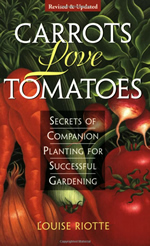
The image above comes from a wonderful book I’m reading titled “Carrots Love Tomatoes” by Louise Riotte. The book’s byline is “Secrets of Companion Planting for Successful Gardening.”
I’ve been gardening (or have been a ‘gardener’s assistant’) for most of my life. In my younger days, we had farm gardens, which were generally pretty good size plots set amidst the grain, hay, or sheep pasture fields. We grew in rows upon rows and I picked potato bugs each summer counting them up for my Mom who reimbursed me for my efforts at a penny apiece. We never thought about companion planting that I recall. However, those were the days when gardening was a no-brainer, and innate sensibilities directed the process.
 It wasn’t until January of last year during a Permaculture Design Certification course at Panya Farm in Thailand that I seriously began to ponder aspects of companion planting. Permaculture is like the expanded version of companion planting—into what might be called companion living, or something more glamorous with an eco- in front of it. Permaculture considers the entire eco-system of a place with the earth, sky, people, plants, and animals synergistically operating. Everything working well together, each element being a good companion to the others.
It wasn’t until January of last year during a Permaculture Design Certification course at Panya Farm in Thailand that I seriously began to ponder aspects of companion planting. Permaculture is like the expanded version of companion planting—into what might be called companion living, or something more glamorous with an eco- in front of it. Permaculture considers the entire eco-system of a place with the earth, sky, people, plants, and animals synergistically operating. Everything working well together, each element being a good companion to the others.
At a certain point, my family, parents, grandparents, moved from the farm to town, taking their gardening skills with them, applying them to the smaller plots of a back yard. It was really quite remarkable! My grandmother put up fruits and vegetables, made jams and pie fillings and whatever else presented itself at the end of the season.
I was afforded the opportunity and experience of how ‘smaller’ could really work. Which brings us back to the image at the top of this post. . .the tiniest garden of all.
Farm-style permaculture works wonderfully, an understanding and application of companion planting lends to increased protection from pests and happier plants, but none of this implies that larger is better.
If a barrier to growing/gardening is the idea that it has to be big, rest assured that small steps taken can lead to more success than you can imagine. And once you achieve a measure of success, you have that as your foundation to grown on.
If it helps you to buy another book. . .please do! Books are wonderful. Carrots Love Tomatoes is incredibly inspiring! But this season, take a step. . .garden in your back yard, join a CSA, get together with your friends over their garden. And realize that the pot of basil growing in the sun in your kitchen window does have its place in the whole scheme of things. Some would call that a garden.
Happy Spring!

